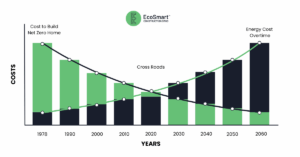See the long-term savings and value by investing in energy-smart homes
This is the first article in a series examining the economics of why Net Zero Homes or Net Zero Ready Homes make financial sense when building a new home. For this series, we focus on new construction, as the cost of retrofitting an existing home is more complicated and expensive than building new. The ROI (return on investment) for updating an existing home with energy efficient updates will take longer than building them into new home to start with. Except in special circumstances. Each year, about 1.2 million new homes are built in the U.S, since you are reading this article, you may be one of those people looking to build a new home.
Why Net Zero Ready Homes Make Financial Sense
So, why is now the right time to consider building a Net Zero Home or a Net Zero Ready home? The answer lies in the economics. The cost of energy is on an upward trajectory, while the necessary upgrades for a Net Zero or Net Zero Ready Home is on a downward trend. This shift in the cost dynamics is a game-changer. Let’s take a look at the big picture.

The Big Picture: Energy vs. Net Zero Home Cost
In 1979, 46 years ago, President Jimmy Carter put 32 solar panels on the roof of the White House. That is the left side of the graph. The intersection in the graph represents today; the right side of the cost intersection looks into the future. This graph visually represents the cost of energy over time, with the left side showing historical costs and the right-side projecting future expenses based on current trends.
As you can see, we are at an intersection between the cost of energy and the cost of building a Net Zero or Net Zero Ready home. We are going to examine the drivers of the rise in energy costs (historical, near, and present future) and how that affects our cost graphs.
The Cost of Net Zero Home Construction
The cost to build or retrofit a Net Zero or Net Zero Ready Home is in decline due to several factors. The cost of solar panels continues to drop and efficiencies are getting better. The current round of solar panels are about 450 watts per panel, the next round coming soon will be around 850 watts per panel at the same cost. The cost of triple-pane and quad-pane windows is decreasing due competition between suppliers as these windows are becoming mainstream not a niche product. The cost of electric Heat pumps for heating and cooling continues to fall while efficiencies are increasing. The electric heat pump hybrid water heater is now the most cost-effective option to install and operate in most new homes. The introduction of the EcoSmart™ Stud has dramatically reduced the cost to build high efficiency exterior walls.
The cost of Net Zero Home or Net Zero Ready Home construction is not limited to a specific building method. Whether you prefer traditional framing, SIPS, ICFs, hempcrete, strawbale, or even repurposed materials such as water bottles, the choice is yours.
Each construction method has its own cost implications and energy efficiency, which can affect the ROI of the upgrade costs. This flexibility offers everyone a selection of construction types, but it also has an impact on ROI. While upfront Net Zero home cost varies, the savings in monthly energy bills add up quickly, paying back the investment in a shorter and shorter time frame.
Stay tuned for our future articles where we’ll discuss build costs and how that affects ROI so you can see why many are turning to Net Zero Homes. We’re excited to share more insights with you.
Up next, The Real Cost of Energy (and why it’s still going up).
